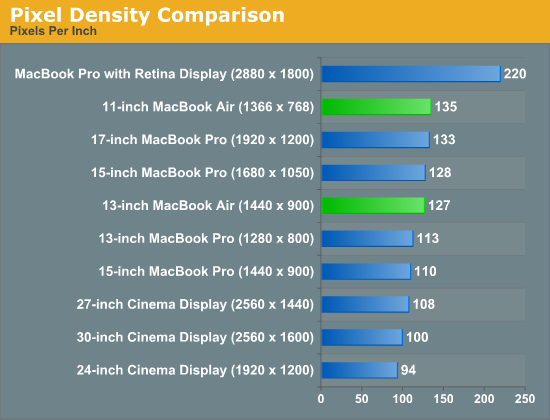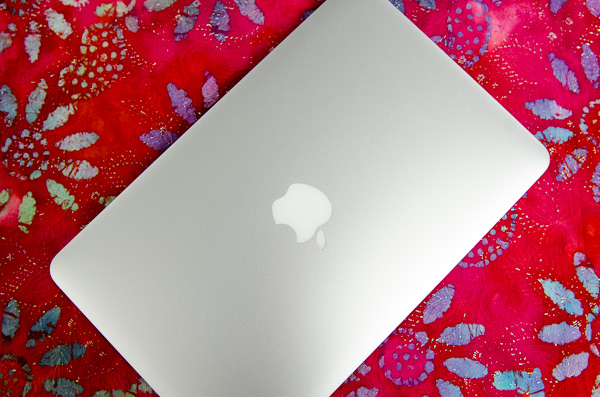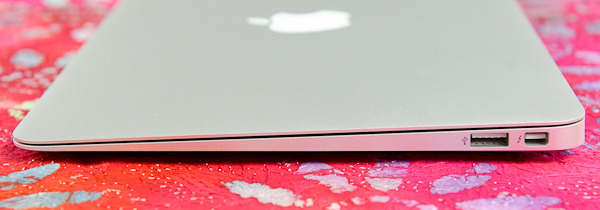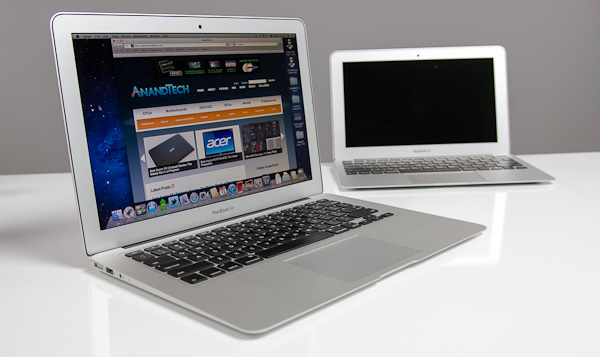The 2012 MacBook Air (11 & 13-inch) Review
by Anand Lal Shimpi on July 16, 2012 12:53 PM EST- Posted in
- Apple
- Mac
- MacBook Air
- Laptops
- Notebooks
Things are getting very blurry.
The MacBook Pro once stood for tons of power plus upgradability. Add a Retina Display and now it's just tons of power. It's a thicker, faster MacBook Air (with an awesome display). It's not bad, in fact it's quite amazing, but it confuses the general order of things.
The MacBook Air doesn't help in the clarity department. You can now order a MacBook Air with up to 8GB of RAM and a 512GB SSD, for the first time in MacBook Air history. Users who were once forced into Pro territory because of RAM and storage requirements can now happily live with an Air. And thanks to Turbo Boost, you do get similar performance in lightly threaded workloads.
Take a step away from the Mac world and you'll see the rest of the market is going through its own confusing period. Nearly every single Microsoft partner is mixing tablets and Ultrabooks. If your tablet uses smartphone hardware, and can dock into a notebook or Thunderbolt itself into a desktop, is all of this a lot of confusion before client computing moves entirely to smartphones? NVIDIA said it would happen publicly (even Intel did so privately a few years ago). Maybe it wasn't just convenient rhetoric. Maybe that's where we're headed. Until then, there are going to be a lot of different form factors, all with very compelling features. The MacBook Air continues to be one of them.
Despite the recent Ultrabook frenzy, the MacBook Air was one of the first (if not the first) to marry performance with usability, screen size/resolution, portability and battery life. Ultraportables prior to the MacBook Air's arrival in 2008 typically sacrificed in one or more of the above areas. I spent years in pursuit of the perfect ultraportable in college over a decade ago (30 is the new 20 right?), and generally came away disappointed and empty handed.
In 2010 Apple changed the expectations of cost with the MacBook Air. The new 11-inch model would start at just $999. And the 13-inch would only cost $300 more. The very first MacBook Air, by comparison, retailed for $1800. Apple took an ultraportable and made it its mainstream notebook. It was a bold move but one that was very forward looking.
Today the MacBook Air is even more affordable. The 11-inch model still starts at $999, but the 13-inch version is only $200 more. From the outside not a lot has changed, but that doesn't mean there's any less to talk about. Ivy Bridge, USB 3.0 and faster SSDs are all on the menu this year. Let's get to it.
The 11 & 13
Unlike the other thin member of Apple's Mac lineup, the MacBook Air chassis hasn't changed over the past three years. Since the 2010 update that gave us the 11-inch model and significantly lower prices, Apple has stuck with a design that only recently has seen widespread emulation.
While our last review focused on the beginning of a new generation, this review takes a look at a very mature, yet still very good design. The MacBook Air is just so pleasant to carry around. It'll make even the new rMBP feel like a pig.
Both the 11 and 13-inch models are effortless to carry around. While I dread traveling with a traditional notebook, slipping one of these into my backpack is barely noticeable. You can get used to and take for granted just about anything, but the form factor of the MacBook Air continues to be a favorite of mine even today.

The 11-inch MacBook Air is a great option for those who want the portability of a tablet but find themselves wanting to attach a keyboard to it most of the time. The 11.6-inch display boasts the highest pixel density of all of Apple's non-retina displays at 1366 x 768, but it's still quite usable. You don't make any sacrifices on keyboard size or key spacing (it's identical to the 13-inch model for the majority of the keys), nor do you have to give up any performance either. Apple offers all of the same CPU, memory and storage upgrades across both MacBook Airs. And with no discrete GPU, thermal throttling isn't really a problem either in the 11-inch chassis. With Thunderbolt, the 11-inch MacBook Air can actually give you the best of both worlds: an incredibly portable computer when you're on the go, and enough to act as your desktop when docked to a Thunderbolt Display.
I've traditionally always bought the 11-inch MacBook Air with the thought that I'd carry it when I didn't need to lug around my MacBook Pro. I seemed to be fooling myself however as over 90% of the time I'd end up with the MacBook Pro. The 11-inch Air was relegated to typewriter duty when I needed a change of scenery while writing at home. It's a great writer's companion, but if I couldn't have more than one system I'd have to opt for its bigger brother.
When I first reviewed the redesigned 13-inch MacBook Air I wrote that it felt more like a normal notebook, while the 11 was something a bit more unique. Perhaps I was more infatuated with the new 11 at the time, because these days I'm more drawn to the 13-inch MacBook Air as the notebook to have if you can only have one.
You get a 23.5% increase in screen resolution on a display that's just easier to look at. While 1440 x 900 is a bit much on a 15-inch MacBook Pro, I'd say it's near perfect on the 13-inch Air. If Apple were to do the Retina treatment on here, it'd be magnificent.
The larger chassis allows room for an SD card reader, which is thankfully quite functional. Otherwise the port layout is identical to the 11-inch model.
| 2012 MacBook Air Lineup | ||||||
| 11.6-inch | 11.6-inch (high-end) | 13.3-inch | 13.3-inch (high-end) | |||
| Dimensions |
H: 0.11-0.68" (0.3-1.7cm) W: 11.8" (30cm) D: 7.56" (19.2cm) |
H: 0.11-0.68" (0.3-1.7cm) W: 12.8" (32.5cm) D: 8.94" (22.7cm) |
||||
| Weight | 2.38 lbs (1.08kg) | 2.96 lbs (1.35kg) | ||||
| Cores/Threads | 1.7GHz dual-core Core i5 | 1.8GHz dual-core Core i5 | ||||
| Base Clock Speed | Intel HD 4000 | |||||
| RAM | 4GB DDR3L-1600 | |||||
| SSD | 64GB SSD | 128GB SSD | 128GB SSD | 256GB SSD | ||
| Display Resolution | 1366 x 768 | 1440 x 900 | ||||
| Ports | Thunderbolt, 2x USB 3.0, headphone jack | Thunderbolt, 2x USB 3.0, SD card slot, headphone jack | ||||
| Price | $999 | $1099 | $1199 | $1499 | ||
In its role as a proponent of simplicity, Apple has reduced the decision between what Air to get down to screen size, resolution and battery life (the 13-inch chassis houses a much larger battery). If you like having more of all of those things, the 13-inch Air is for you. If carrying anything larger than a tablet upsets you, buy the 11.




















190 Comments
View All Comments
Pneumothorax - Monday, July 16, 2012 - link
The only way some of the anti-apple fanbois here are going to be placated is if you filled the review with "This laptop is too expensive" "All the other PC ultrabooks including Acer is better" "Don't drink the Apple kool-aid"As a Win7/OSX user myself, I find your reviews to be the most fair and thorough in reviewing Apple products. The earlier rMBP/MBA reviews by others seemed to just read as a re-written Apple press-release.
PS Your rMBP review finally convinced me to get the rMBP, so you could be an Apple shill after all lol.
ananduser - Monday, July 16, 2012 - link
How do you like it so far ?Is 3rd party compatibility an issue with the large panel ?
Have you noticed the UI lag(from the review) when you're mulitasking ?
Does it really get that hot ?
Pneumothorax - Monday, July 16, 2012 - link
Best laptop I've owned and I've had Alienware, Dell, Asus, Lenovo, and the worst - HP. The panel still has teething issues with MS office and lightroom/CS5. The lag is there, but the screen is so good it's overlooked. Tried a buddy's rMBP that has the golden master Mountain Lion installed on it and it's much much smoother than Lion. Mountain lion is to Lion like Win7 was to Vista. Lion is a slow/memory hog.Heatwise, it's much cooler and QUIETER than my 2011 MBP 15. D3 on my 2011 MBP would remind me of Delta CPU fans on prescott CPU ages ago, D3 on my rMBP = fans barely audible.
KoolAidMan1 - Monday, July 16, 2012 - link
Sounds like you're angry because of your own personal biasLepton87 - Tuesday, July 17, 2012 - link
Sadly, I must agree. Lines like that"There's no denying that what ASUS has done is better, it's just not perfect. And as Apple has shown us in the past, it's not fond of stopgap solutions."
Seriously? 200dpi on a 11'' screen is a stopgap solution?
I'm never reading an apple review made by anand again.
KPOM - Tuesday, July 17, 2012 - link
What he means is that Apple likely won't change the screen resolution until they can quadruple it (2880x1800 on the 13.3" and 2732x1536 on the 11.6"). If they go with straight 1080p on the 13" or 11" as ASUS is doing, they would likely have to use a 1.5x scaling option to avoid small text. That isn't something that Apple is likely to do in OS X. So yes, it would be stop gap for Apple, even though it might not be a stop gap for ASUS.Freakie - Tuesday, July 17, 2012 - link
I agree with you De_Com. While Anand still adheres to relatively object testing methods, there is no doubt that the tone throughout any of these Apple products reviews clearly shows Anand's personal opinion towards Apple products. It is a bit disconcerting to come to Anandtech and have just this one little niche seemingly out of place in the large supply of amazing reviews. Thankfully it doesn't happen very often, but it does feel like it totally goes against the grain of all of the other Anandtech reviews.And I echo that I would love to see one of the other writers do one of these Apple reviews. It does seem odd that Anand is always the reviewer, when other reviewers mention owning Apple products and would seem to be able to have the ability to compare Apples to Apples just fine, as well as the rest of the market.
But in the end, this IS Anand's website, and I of course still respect him and the website he has built and while I may not agree with every part of it, I also do not understand every part of him and his opinions and decisions so there very well could just be something that we are missing from our own opinions on the matter.
De_Com - Tuesday, July 17, 2012 - link
Nice to see my comment sparked a bit of lively debate, although I did know I'd get one or two thoughtless responses i.e "oh these Apple haters" or "but it's cool to bash Apple", EnzoFX and Kpom I'm looking at you !Also nice to see Anand respond as well.
I believe Sunburn74 said it best when he likened our subconscious wish not to dismiss or deconstruct the things we use ourselves as it somehow goes against our own wishes.
It was nice to see others also call for another reviewer to be given a crack at an Apple Notebook.
One more thing :- Love the site, Love the reviews, keep it up Anand.
KPOM - Friday, July 20, 2012 - link
Thoughtless response? That describes you a lot more than me. Also, in case you didn't notice, Anand did NOT review the new non-Retina MacBook Pro.phillyry - Tuesday, March 26, 2013 - link
Precisely because he didn't care about the non-retina 15" MBP (that's my conclusion anyways).I mean, if you were the head of this website wouldn't you choose to do the reviews that you actually cared about?
I think Anand's been pretty clear about his preference for MacBooks and his absolute obsession with SSDs. Why wouldn't he have a preference (or bias, if you must) for the best excited hardware, with software that he likes, that's going in the direction that he thinks is the future of the notebook industry, namely small form factor ultraportables based on SSDs.
I really don't see the fuss and actually enjoy seeing Anand enjoy doing his work (writing reviews).
It would be nice if people could move past the fanboism debate that rages across the Internet nd just discuss the points made in the review and, imagine this, even the device itself!